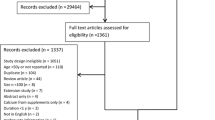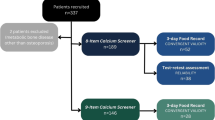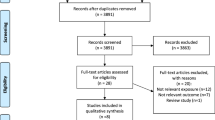Abstract
Objective:
To describe associations between sociodemographic factors and calcium intake in premenopausal women.
Design:
Cross-sectional study.
Setting:
Population-based.
Subjects:
A total of 467 randomly selected, predominantly Caucasian Tasmanian women aged 25–44 y, response rate 63%.
Main outcome measures:
calcium intake, sociodemographic factors, anthropometrics, osteoporosis knowledge and self-efficacy.
Results:
Education level, calcium-specific osteoporosis knowledge and self-efficacy were all independently associated with calcium intake (P<0.05). The odds of achieving the recommended dietary intake for calcium increased with higher levels of calcium-specific self-efficacy and knowledge, and decreased in smokers or if the household's main financial provider was unemployed (P<0.05).
Conclusions:
Women who have lower levels of education, who are in households where the main financial provider is unemployed, who are smokers, and those with low levels of calcium-specific self-efficacy and knowledge are at risk of not achieving adequate calcium intake. This information will assist targeting of public health strategies aimed at improving the calcium intake of premenopausal women.
Sponsorship:
This study was supported by a National Health and Medical Research Council grant and the Government of Tasmania.
This is a preview of subscription content, access via your institution
Access options
Subscribe to this journal
Receive 12 print issues and online access
$259.00 per year
only $21.58 per issue
Buy this article
- Purchase on Springer Link
- Instant access to full article PDF
Prices may be subject to local taxes which are calculated during checkout
Similar content being viewed by others
References
Angus RM, Sambrook PN, Pocock NA & Eisman JA (1989): A simple method for assessing calcium intake in Caucasian women. J. Am. Diet Assoc. 89, 209–214.
Bandura A (1986): Social Foundations of Thought and Action. Englewood Cliffs, NJ: Prentice-Hall.
Department of Health and Human Services (1999): Health and Wellbeing in Tasmania. Hobart: Department of Health and Human Services.
Griffith LE, Guyatt GH, Cook RJ, Bucher HC & Cook DJ (1999): The influence of dietary and nondietary calcium supplementation on blood pressure: an updated metaanalysis of randomized controlled trials. Am. J. Hypertens. 12, 84–92.
Guthrie J (1996): Dietary patterns and personal characteristics of women consuming recommended amounts of calcium. Family Econom. Nutr. Rev. 9, 33–49.
Heaney RP, Davies KM & Barger-Lux MJ (2002): Calcium and weight: clinical studies. J. Am. Coll. Nutr. 21, 152S–155S.
Horan ML, Kim KK, Gendler P, Froman RD & Patel MD (1998): Development and evaluation of the Osteoporosis Self-Efficacy Scale. Res. Nurs. Health 21, 395–403.
Jones G & Scott FS (1999): A cross-sectional study of smoking and bone mineral density in premenopausal parous women: effect of body mass index, breastfeeding, and sports participation. J. Bone Miner. Res. 14, 1628–1633.
Krall EA & Dawson-Hughes B (1999): Smoking increases bone loss and decreases intestinal calcium absorption. J. Bone Miner. Res. 14, 215–220.
Lewis N & Hollingsworth M (1992): Food choices of young college women consuming low- or moderate-calcium diets. Nutr. Res. 12, 943–948.
NIH Consensus Statement (2000): Osteoporosis Prevention, Diagnosis and Therapy. NIH Consensus Statement 2000, Mar 27–29, Vol. 17, pp 1–45.
National Health and Medical Research Council (1991): Recommended dietary intakes for use in Australia. National Health and Medical Research Council, Commonwealth of Australia.
Piaseu N, Schepp K & Belza B (2002): Causal analysis of exercise and calcium intake behaviors for osteoporosis prevention among young women in Thailand. Health Care Women Int. 23, 364–376.
Reid IR, Mason B, Horne A, Ames R, Clearwater J, Bava U, Orr-Walker B, Wu F, Evans MC & Gamble GD (2002): Effects of calcium supplementation on serum lipid concentrations in normal older women: a randomized controlled trial. Am. J. Med. 112, 343–347.
Weingarten MA, Zalmanovici A & Yaphe J (2003): Dietary calcium supplementation for preventing colorectal cancer and adenomatous polyps. The Cochrane Database of Systematic Reviews Issue I. Art. No.: CD003548.pub2. DOI: 10.1002/14651858.CD003548. pub2.
Welsh S & Guthrie J (1991): Changing American diets. In Micronutrients in Health and in Disease Prevention, eds Bendich A, Butterworth C, pp 381–408. New York: Marcel Dekker, Inc.
Winzenberg T, Oldenburg B, Frendin S & Jones G (2003): The design of a valid and reliable questionnaire to measure osteoporosis knowledge in women: the Osteoporosis Knowledge Assessment Tool (OKAT). BMC Musculoskeletal. 4, 17.
Woo J, Leung SS, Ho SC, Sham A, Lam TH & Janus ED (1999): Influence of educational level and marital status on dietary intake, obesity and other cardiovascular risk factors in a Hong Kong Chinese population. Eur. J. Clin. Nutr. 53, 461–467.
Zemel MB (2001): Calcium modulation of hypertension and obesity: mechanisms and implications. J. Am. Coll. Nutr. 20, 428S–435S; discussion 440S–442S.
Author information
Authors and Affiliations
Corresponding author
Additional information
Guarantor: TM Winzenberg.
Contributors: TW analysed the data except for calculation of calcium intake from the food frequency questionnaire, which was performed by MR. TW drafted the paper, with input from the other authors. GJ, BO, MR and SF designed the study and provided editorial advice on the paper. Dr Jones managed the data collection for the study.
Rights and permissions
About this article
Cite this article
Winzenberg, T., Riley, M., Frendin, S. et al. Sociodemographic factors associated with calcium intake in premenopausal women: a cross-sectional study. Eur J Clin Nutr 59, 463–466 (2005). https://doi.org/10.1038/sj.ejcn.1602105
Received:
Revised:
Accepted:
Published:
Issue Date:
DOI: https://doi.org/10.1038/sj.ejcn.1602105
Keywords
This article is cited by
-
The effects of smoking on bone metabolism
Osteoporosis International (2012)
-
Self-efficacy and Dietary Fat Reduction Behaviors in Obese African-American and White Mothers
Obesity (2008)



